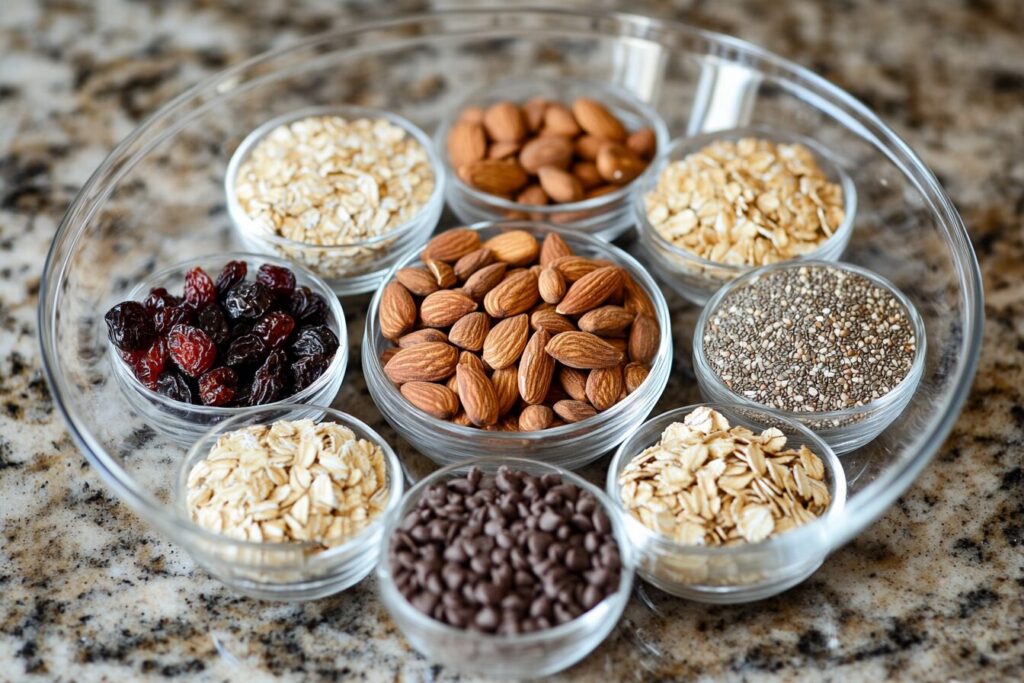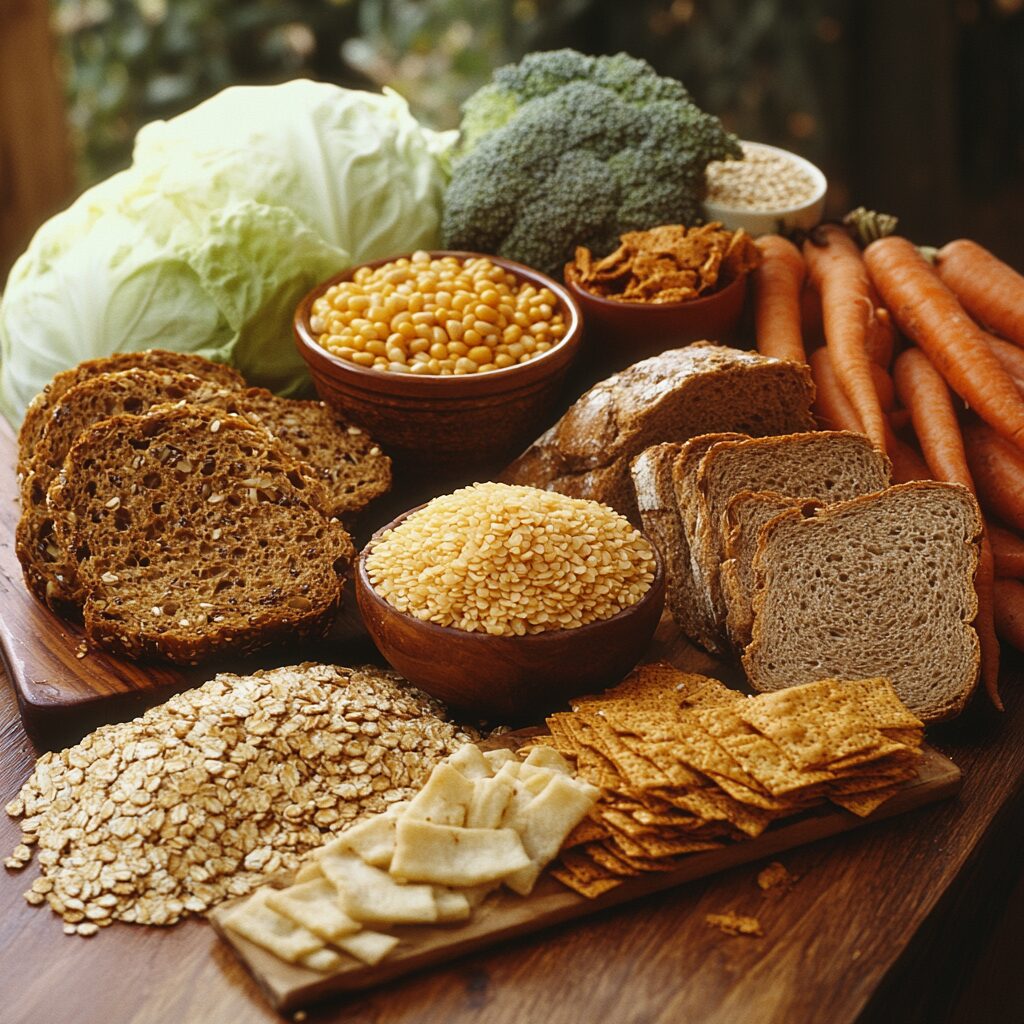Fiber is a type of carbohydrate that your body can’t digest. While most carbohydrates break down into sugar molecules, fiber cannot be broken down into sugar molecules and instead passes through the body undigested. It helps regulate the body’s use of sugars, helping to keep hunger and blood sugar in check. Fiber is essential for healthy digestion and offers several other health benefits.
Table of Contents
There are two main types of fiber:
- Soluble Fiber: This type of fiber dissolves in water to form a gel-like substance. It can help lower blood cholesterol and glucose levels. Soluble fiber is found in foods like oats, barley, nuts, seeds, beans, lentils, and fruits like apples, citrus fruits, and strawberries.
- Insoluble Fiber: This type of fiber does not dissolve in water and helps add bulk to your stool, aiding in the movement of material through your digestive system. It can be particularly beneficial for those who struggle with constipation or irregular bowel movements. Insoluble fiber is found in foods like whole grains, wheat bran, vegetables, and legumes.
Including a mix of both types in your diet is important for maintaining optimal health.
Benefits of fiber
Dietary fiber can offer the following benefits:
- Fiber in the digestive system can assist in lowering cholesterol absorption within the body. This effect is particularly beneficial when combined with statins or fiber supplements like psyllium fiber.
- Promoting a healthy weight: High fiber foods like fruits and vegetables tend to be lower in calories and slow digestion to help you feel fuller for longer.
- Preventing constipation: Fiber can speed up digestion and prevent constipation. Insoluble fiber adds bulk to the digestive tract, as your body doesn’t digest it. This stimulates the intestines.
- Managing blood sugar: The body takes longer to break down high fiber foods, which means glucose does not enter the bloodstream so quickly. This helps you maintain more consistent blood sugar levels.
- Reducing cancer risk: Eating enough fiber may help prevent certain cancers, including colon cancer. One reason may be that some types of fiber, such as the pectin in apples, may have antioxidant properties.
If you’re adding high-fiber foods to your diet, do so gradually over a few days and drink plenty of water, too. This can help prevent adverse effects, such as bloating and gas.

22 high fiber foods to eat
1. Pears
Pears are both tasty and nutritious and can satisfy a sweet tooth. They are also a good source of fiber.
Content: 5.5 grams in a medium-sized, raw pear, or 3.1 grams per 100 grams.
2. Strawberries
Strawberries are a delicious, healthy option for eating fresh as a summer dessert or as an office snack.
As well as fiber, they also contain vitamin C, manganese, and various antioxidants.
Content: 3 grams in 1 cup of fresh strawberries, or 2 grams per 100 grams
3. Avocado
The avocado is high in healthy fats and a good source of fiber.
It also provides vitamin C, potassium, magnesium, vitamin E, and various B vitamins.
Content: 10 grams in 1 cup of raw avocado, or 6.7 grams per 100 grams.
4. Oats
Oats are an excellent source of fiber and are high in vitamins, minerals, and antioxidants.
They contain a powerful soluble fiber called beta glucagon, which may help manage blood sugar and cholesterol levels.
Content: 16.5 grams per cup of raw oats, or 10.1 grams per 100 grams.
5. Apples
Apples are a tasty and satisfying fruit. Eaten whole, they also provide both soluble and insoluble fiber.
Content: 4.4 grams in a medium-sized, raw apple, or 2.4 grams per 100 grams.
6. Raspberries
Raspberries are a nutritious fruit with a distinctive flavor. They contain fiber, vitamin C, and manganese.
Content: One cup of raw raspberries contains 8 grams of fiber, or 6.5 grams per 100 grams.
Other high-fiber berries
Here are some other berries you can add to desserts, oatmeal, and smoothies or just snack on during the day:
- Blueberries: 2.4 grams per 100-gram serving
- Blackberries: 5.3 grams per 100-gram serving
7. Bananas (2.6 grams)
Bananas provide many nutrients, including vitamin C, vitamin B6, and potassium.
A green or unripe banana also contains a significant amount of resistant starch, an indigestible carbohydrate that functions like fiber.
Content: 3.1 grams in a medium-sized banana, or 2.6 grams per 100 grams.
8. Carrots
The carrot is a root vegetable you can eat raw or cooked.
In addition to fiber, carrots provide vitamin K, vitamin B6, magnesium, and beta carotene, an antioxidant that gets turned into vitamin A in your body.
Content: 3.6 grams in 1 cup of raw carrots, or 2.8 grams per 100 grams.
9. Beets
The beet, or beetroot, is a root vegetable that contains valuable nutrients, such as folate, iron, copper, manganese, and potassium.
Beets also provide inorganic nitrates, nutrients that may have benefits for blood pressure regulation and exercise performance.
Content: 3.8 grams per cup of raw beets, or 2 grams per 100 grams.
10. Broccoli (2.6 grams)
Broccoli is a type of cruciferous vegetable and a nutrient-dense food.
It provides fiber and also contains vitamin C, vitamin K, folate, B vitamins, potassium, iron, and manganese. It also contains antioxidants and other nutrients that may help fight cancer. Broccoli is also relatively high in protein, compared with other vegetables.
Content: 2.4 grams per cup, or 2.6 grams per 100 grams.
11. Artichoke
Artichokes are high in many nutrients and are a good source of fiber.
Content: 6.9 grams in 1 raw globe or French artichoke, or 5.4 grams per 100 grams.
12. Brussels sprouts
Brussels sprout are cruciferous vegetables related to broccoli.
They contain fiber and are also high in vitamin K, potassium, folate, and potentially cancer-fighting antioxidants.
Content: 3.3 grams per cup of raw Brussels sprouts, or 3.8 grams per 100 grams.
Most vegetables contain significant amounts of fiber.
Other notable examples include:
- Kale: 4.1 grams
- Spinach: 2.2 grams
- Tomatoes: 1.2 grams
13. Lentils
Lentils are economical, versatile, and highly nutritious. They are a good source of fiber, protein, and many other nutrients.
Content: 13.1 grams per cup of cooked lentils, or 10.7 grams per 100 grams.
14. Kidney beans
Kidney beans are a popular type of legume. Like other legumes, they provide plant-based protein and various nutrients.
Content: 12.2 grams per cup of cooked beans, or 7.4 per 100 grams.
15. Split peas
Split peas are made from the dried, split, and peeled seeds of peas. They’re often seen in split pea soup served alongside ham, but can be used in dhals and other recipes.
Content: 16.3 grams per cup of cooked split peas, or 8.3 per 100 grams.
16. Chickpeas
The chickpea is another type of legume that’s rich in fiber and also provides protein and various minerals
Chickpeas feature in hummus, curries, soups, and many other dishes.
Content: 12.5 grams per cup of cooked chickpeas, or 7.6 per 100 grams.
Other high fiber legumes
Most legumes are high in protein, fiber, and various nutrients. Prepared correctly, they offer a tasty and economical source of quality nutrition.
Other legumes include:
- Cooked Black beans: 8.7 grams
- Cooked Edamame: 5.2 grams
- Cooked Lima beans: 7 grams
- Baked beans: 5.5 grams
17. Quinoa
Quinoa is a pseudo-cereal that provides fiber and is a useful source of protein for those on a plant-based diet.
It also contains magnesium, iron, zinc, potassium, and antioxidants, to name a few.
Content: 5.2 grams per cup of cooked quinoa, or 2.8 per 100 grams.
18. Popcorn
Popcorn can be a fun and healthy way to increase fiber.
Air-popped popcorn is very high in fiber, calorie for calorie. However, if you add fat or sugar, the fiber-to-calorie ratio will start to decrease significantly.
Content: 1.15 grams per cup of air-popped popcorn, or 14.5 grams per 100 grams.
Nearly all whole grains are high in fiber.
19. Almonds
Almonds are high in many nutrients, including healthy fats, vitamin E, manganese, and magnesium.
They can also be made into almond flour for baking.
Content: 4 grams per 3 tablespoons, or 13.3 grams per 100 grams.
20. Chia seeds
Chia seeds are highly nutritious, tiny black seeds. They are an excellent source of fiber and contain high amounts of magnesium, phosphorus, and calcium.
Try chia seeds mixed into jam or add them to homemade granola bars.
Content: 9.75 grams per ounce of dried chia seeds, or 34.4 grams per 100 grams.
In summary, dietary fiber is a non-digestible carbohydrate that is vital for maintaining overall health. It is categorized into two types: soluble fiber, which dissolves in water and supports heart health and blood sugar regulation, and insoluble fiber, which adds bulk to stool and aids in digestive regularity. Incorporating a variety of fiber-rich foods like fruits, vegetables, legumes, whole grains, and nuts into your diet offers numerous health benefits, such as improved digestion, better weight management, reduced risk of chronic diseases, and stabilized blood sugar levels. Gradual fiber intake combined with adequate hydration is key to reaping its benefits while minimizing potential side effects like bloating.
